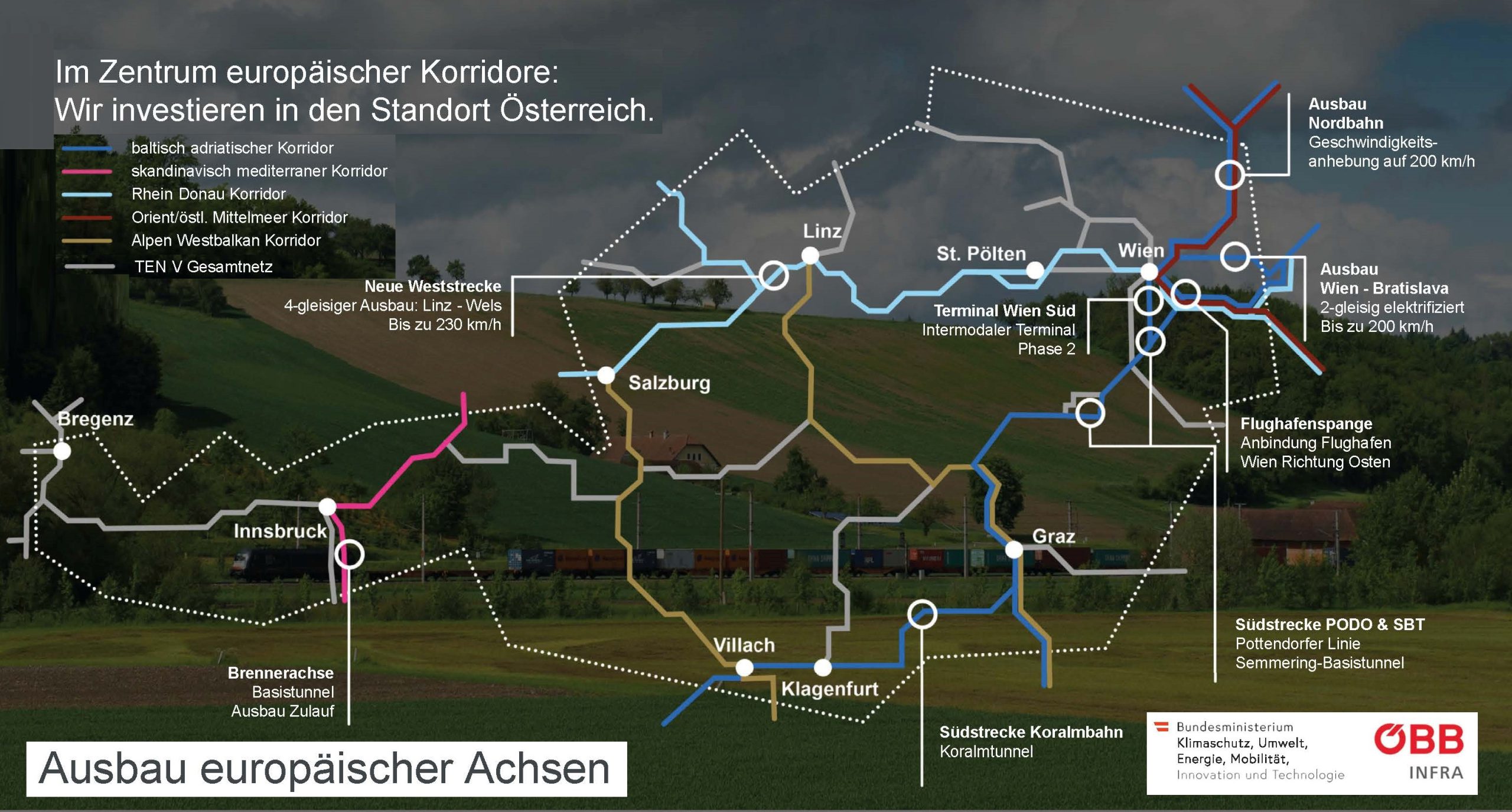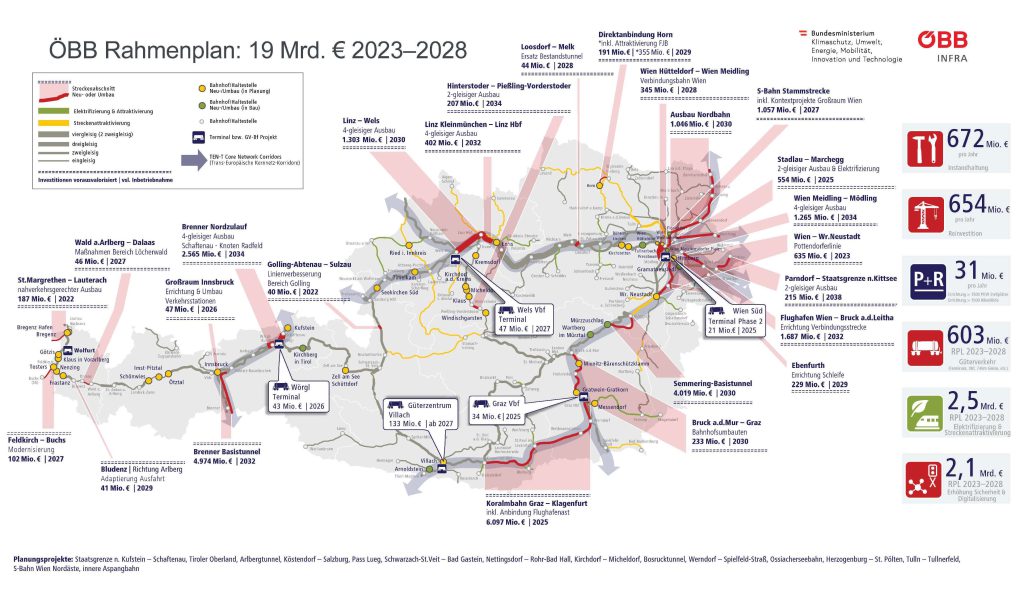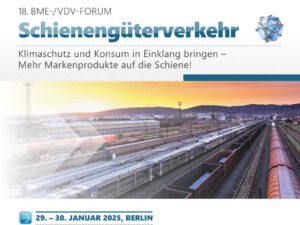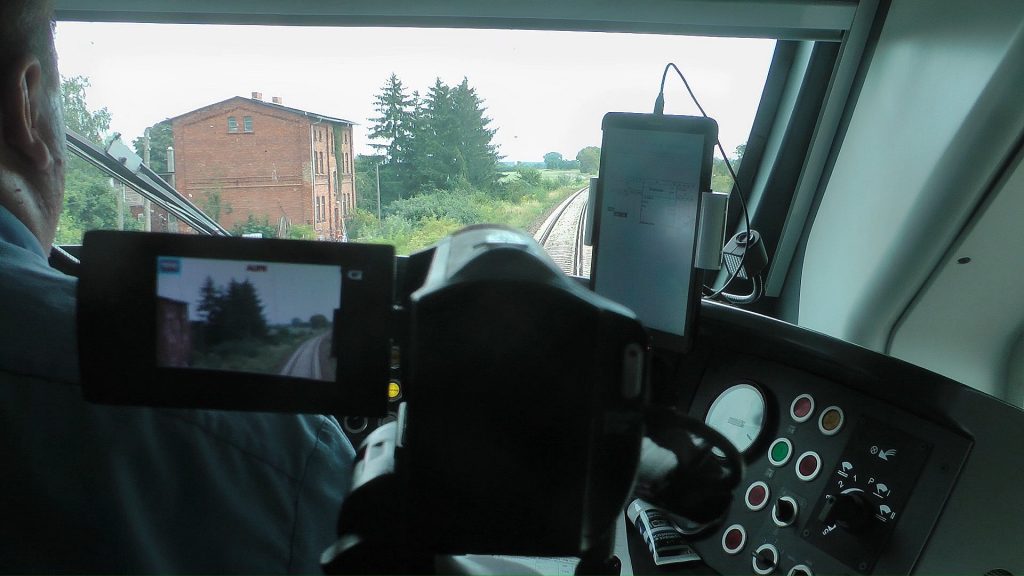Austria’s government, the Council of Ministers, decided this by circulation, explained the Minister for Climate Protection and Transport Leonore Gewessler (Greens) on October 22, 2022. The new financial framework is the “largest railway package in the history of the republic” and “an announcement in the fight against Inflation, energy and climate crisis. Because traveling by train is easy on the wallet, saves energy and protects the climate. Investments in the railway therefore pay off two or three times over.”
Compared to the previously valid framework plan, even more investments will be made in the accessibility of train stations in the next six years. Account is also taken of the increasing trend towards handling more freight traffic by rail. Among other things, a revised funding system for connecting railways to companies and an amendment to the Waste Management Act provide incentives for this. The framework plan 2023-2028 therefore also provides additional funds for the construction and adaptation of goods loading points. This should make bimodal transport even more attractive.
The framework plan envisages a large number of different projects with which the railway infrastructure will be made future-proof. These include the digitisation and automation of rail traffic through the further development of electronic interlockings and the upgrade of the train control system to the European system ETCS (European Train Control System). The automated operational management is intended to expand capacities and optimize punctuality and safety.
Electrification will be further increased
By the end of 2021, 74 percent of Austrian railway lines were already electrified. Further electrification of railway lines over 500 km in length is planned by 2030. These include the Marchegger Ostbahn and Traisentalbahn. ÖBB President Andreas Matthä also announced that new vehicles with electric drives should also be purchased. The current tender for a framework agreement for up to 120 battery driven multiple units should be completed in spring 2023. These can then operate both in the electrified and in the non-electrified area and thus also decarbonise railway lines without electrical overhead lines.
It is gratifying that all major projects planned so far are being continued. These include the Koralmbahn with the Koralmbahn tunnel between Styria and Carinthia and the Semmering base tunnel between Styria and Lower Austria on the southern railway. In Tyrol, the Brenner base tunnel is being excavated. In the central area of Upper Austria between Linz and Wels, the Western Railway is to be expanded to four tracks. The expected end of construction has been postponed at various points. During the Linz – Marchtrenk expansion, there were objections to the railway law and nature conservation law notice. These are currently being examined by the Federal Administrative Court. It is therefore now assumed that it will be commissioned in 2030.
The Marchtrenk – Wels project, on the other hand, is running according to plan. Due to the mutual operational dependencies, the four-track through connection of the western line between Linz Kleinmünchen and the east side of Linz main station can only be realized later, by 2032.
All projects continue – but sometimes with a delay
There are also adjustments to the commissioning of the new Schaftenau – Radfeld junction. This is also based on the updated planned commissioning of the Brenner Base Tunnel (probably in 2032) and is now planned for 2034. The transition phase of two years can be covered by the capacity of the existing line.
Further postponements relate to the adaptation of the Arlberg exit near Bludenz: 2026 -> 2029, northern access to the Brenner Pass: 2032 -> 2034; Worgl Terminal: 2025 -> 2026; Catfish Vbf: 2026 -> 2027; Linz – Wels: 2028 -> 2030; Linz Kleinmünchen – Linz Hbf: 2030 -> 2032; the direct connection Horn: 2027 -> 2029; Vienna Hütteldorf – Meidling: 2027 -> 2028; Parndorf-Kittsee 2 tracks: 2035 -> 2038; Semmering Base Tunnel: 2028 -> 2030 as well as Graz – Bruck train station renovations: 2027 -> 2030. Only the connection from Vienna Airport to Bruck/Leitha was given high priority from 2034 to 2032.
From 2024 only trains with whisper brakes
To ensure that the population does not lose sleep due to the increased volume of freight trains, it will be mandatory for all freight wagons to be equipped with the quiet, so-called whisper brakes by the end of 2024. Other noise protection measures will also be continued. The upgrading of the rail infrastructure particularly affects the European transport corridors. It will thus have a positive influence on the handling of freight traffic.

In local transport, investments flow into the main S-Bahn line in Vienna and its tributaries in the surrounding area. In Vorarlberg, a further expansion of the Rheintal-Wallgau local transport is on the agenda. In this area, the regional authorities also provide subsidies for the costs of the respective construction measure. The basis for this is Section 44 of the Federal Railways Act for the expansion of infrastructure of particular regional interest. This can, for example, affect the attractiveness of traffic stations and routes, noise barriers, park & ride facilities, station forecourts and level crossings in accordance with the provisions of the Railways Act.
According to the Ministry of Climate Affairs, the negotiations on the cost contributions of the local authorities are generally conducted by ÖBB-Infrastruktur AG on the basis of general guidelines from the BMK. The finances for the tasks of the framework plan are usually secured by the Council of Ministers presenting the draft of a federal law together with the ÖBB framework plan, with which the Federal Minister for Climate Protection, Environment, Energy, Mobility, Innovation and Technology justifies previous burdens is hereby approved.
This draft of a preload law will subsequently be forwarded to the National Council for constitutional treatment. As a next step, the subsidy contracts between the federal government and ÖBB-Infrastruktur AG can be concluded, which represent the contractual basis for the implementation of the investments.
The projects are not financed individually, explains the ministry. Rather, ÖBB-Infrastruktur AG finances the project portfolio via the Austrian Federal Financing Agency (ÖBFA) on the capital market. For repayment, the federal government grants a subsidy for each year based on the investment volume of ÖBB-Infrastruktur AG.
Hermann Schmidtendorf, Editor-in-Chief









